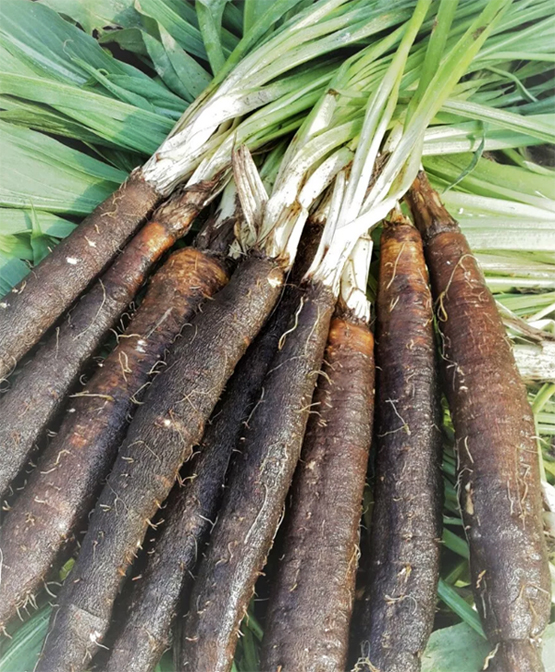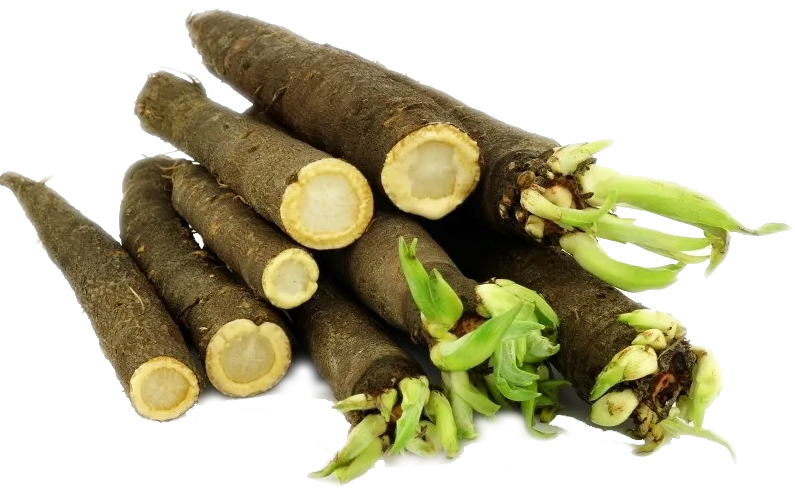A perennial, dietary vegetable. Grows well in sandy loam or light loam, humous soil. Can endure a winter if left in the soil. The crop is harvested in late autumn or in early spring. Roots, if layered with sand, can be stored in a basement during winter. Nut taste, valuable and tasty roots are used as food. Suitable for fresh consumption, frying, stewing and drying.
1,0 g = 90-100 seeds.

Root crops (to a lesser extent - leaves) are rich in sugars (about 20%), vitamins C, B1, B2, salts of potassium, manganese, iron, copper, zinc, phosphorus, calcium. But its main advantage is the high content of inulin in the roots (about 10%), as well as asparagine, levulin. This plant is just a medicine for diabetics!
In addition, scorzonera roots contain up to 2% pectin. And she is a good honey plant!
Agricultural technology.
Scorzonera gives good yields only on neutral, humus-rich, fertilized, deeply (30-40 cm) cultivated soils. On clayey, dense soils, as well as when fresh manure is applied, root crops turn out to be ugly, branch, and a full-fledged crop cannot be obtained. The culture is responsive to mineral fertilizers.
Scorzonera seeds are large, 15-20 mm long, about 1.5 mm thick, ribbed, grayish. Weight of 1000 seeds 15-20 g.
Sow better with fresh seeds (germination lasts 1-2 years). It is better to germinate them for 5-7 days at a temperature of +25°C. After 10 days, the sprouted ones are selected and sown, the rest are washed and germinated for another 5-7 days, then sown. Seeding scheme 20 x 8-10 cm, seeding depth 2-3 cm.
In Estonian conditions, scorzonera is usually sown in mid-May. Shoots appear on the 4-10th day at a temperature of about +20°C. To shift the timing of use to earlier, you can sow in July and September.
Care consists of watering and weeding. Feed crops twice a month until mid-August with complex mineral fertilizers with trace elements.
Root crops are ready for harvesting 100-110 days after germination. They begin to harvest after two months of growth, but they are usually harvested for storage in the middle - the end of September when they reach a mass of 100-150 g.
When harvesting, root crops must be dug up, freeing them from the soil with their hands.
In boxes with sand, only not injured, but healthy root crops are laid. The sand is kept moist during the entire storage period.
Some of the crops are left before winter and used immediately after the soil thaws, before shooting. Moreover, their taste only improves, but with the onset of shooting, it deteriorates sharply (!).
You can take care of the supply of scorzonera seeds yourself. For this, part of the crops is left before winter. In early spring, the plants grow back and produce flower stalks in June. Inflorescence - basket, yellow flowers. As soon as the inflorescences look like a "fluffy" dandelion, they are plucked and laid out in a ventilated room for drying and ripening, and then ground. Well-ripened seeds usually have a germination rate of 80-90% in the first year, and only 30-40% in the second.

Black salsify. Bot. syn.: Scorzonera crispatula Boiss.
* Black salsify root crops are prepared for future use in dried and frozen form (they are also used to make a coffee surrogate).
First of all, use broken, injured specimens.
Scorzonera is an excellent component of canned vegetables. A variety of dishes are prepared from its roots.
Fresh root vegetables are sweetish in taste, and they are used to prepare a variety of salads, vinaigrettes, side dishes, soups, and drinks. In the spring, bleached leaves, like those of an white salsify are used for salads.
Salad of boiled root vegetables.
Wash, peel, boil the root crops in water acidified with vinegar or lemon juice. Cut into pieces, add lemon juice, dill, parsley, basil, cilantro. Season with vegetable oil or mayonnaise. Salt to taste.
Salad of fresh root vegetables.
Root vegetables of black salsify and carrots (1:1) wash, grate on a coarse grater "straws", sprinkle with lemon juice, salt, add herbs, season with vegetable oil, sour cream, mayonnaise. You can add the root of Witloof chicory salad, grated on a coarse grater.
Black salsify soup.
Peel the root vegetables, cut into pieces and cook until soft in salted water or broth. Remove half of them, rub through a sieve and put back into the pan. Add parsley, yolk and a little sour cream. Drizzle with oil before serving.













